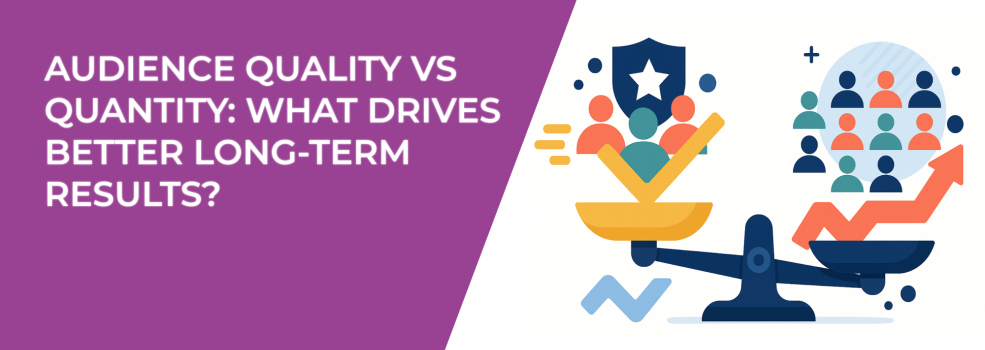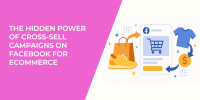When planning ad campaigns, most marketers face the same dilemma:
Should you aim to reach more people — or the right ones?
High-reach campaigns can look impressive on the surface. But if your audience doesn’t care, doesn’t click, and doesn’t convert, does the volume really matter?
Let’s explore why audience quality is quickly becoming the deciding factor in sustainable advertising performance — and how to build audiences that actually convert.
What Makes an Audience “High Quality”?
Audience quality is about relevance and intent.
A high-quality audience doesn’t just look good on paper — it performs well because the people in it are more likely to:
-
Understand the value of your product,
-
Recognize their need for what you offer,
-
Be actively looking for a solution in your category,
-
Take action (click, sign up, purchase).
For example:
-
A brand selling high-performance cookware might see better results targeting people who have recently interacted with long-form recipe content — rather than a broad group like “home chefs.”
-
A company offering ergonomic office setups could build stronger audiences from people who visited pages like “lower back pain at desk” or followed Facebook groups for remote workers.
-
A subscription supplement business is more likely to convert users who engaged with a buyer’s guide or product comparison — not those who just “liked” a general wellness post.
The key here is relevance — not reach.
Not sure how to define what a “high-quality” audience looks like for your brand? Start here with this step-by-step guide to identifying your ideal target audience.
Why Marketers Still Prioritize Quantity (and Why It Often Backfires)
There’s a reason advertisers fall into the "bigger is better" mindset.
Large audiences often result in lower CPMs. Broader reach can generate more impressions. Algorithms are designed to scale. So in theory, casting a wide net should help.
But here’s what often happens:
-
Your ads get a lot of views, but very few clicks,
-
Your retargeting audiences fill up with low-intent users,
-
Your pixel gets trained on behaviors that don’t lead to conversions,
-
You end up paying more per sale, even if your CPM stays low.
This leads to campaigns that look healthy in a dashboard — but underperform when it comes to actual revenue.
When you prioritize audience size over audience fit, you often get more traffic — just not the kind you want.
The Hidden Cost of Low-Quality Traffic
Let’s say you’re running ads for a digital planner tool.
You decide to target a massive audience of people interested in “productivity” and “time management.” The results? Plenty of traffic, very little return.
Why?
Because “interest” is vague. You may be reaching students, managers, entrepreneurs, and casual browsers — people with completely different needs, attention spans, and buying behavior.
Now imagine building an audience from users who:
-
Visited your blog post on “How to build a daily routine using digital tools”,
-
Engaged with competitor products on social media,
-
Are members of productivity-focused Facebook groups.
These individuals are already in the mindset to take action — and your product is a better fit for their current needs.
That’s the value of audience quality: more alignment, less guesswork.
How to Focus on Quality Without Losing Reach
This doesn’t mean limiting your audience to a tiny niche. It means using better signals and smarter targeting to reach the right people — at the right time.
Here’s how to get started:
1. Move Beyond Interests — Build Custom Audiences That Reflect Intent
Interest-based targeting used to work well, but it’s less effective today. Instead, focus on actual behavior:
-
Site visitors who spent time on product pages,
-
Users who engaged with educational content,
-
Past purchasers with high lifetime value,
-
People who clicked on high-intent CTAs (like “compare plans” or “get pricing”).
You can also try targeting people who follow relevant Facebook groups. For example:
-
A DTC fitness brand can target users from niche groups like “Home Workout Equipment Reviews” or “Gym-Free Strength Training.”
-
A skincare company can target audiences involved in groups like “Sensitive Skin Solutions” or “Fragrance-Free Products.”
-
A B2B SaaS tool can focus on members of marketing or startup communities who are actively seeking solutions.
Want to try this out? Use LeadEnforce to create custom audiences from Facebook group members. These are people already discussing your category, your competitors, or your problem space.
2. Use Your First-Party Data Strategically
Your own data is often the most valuable. Use it to create high-intent segments like:
-
Repeat buyers
-
Customers who purchased specific product lines
-
Users who opened your last 3 emails or clicked a CTA
-
Visitors who added to cart but didn’t convert
These audiences are already warmed up — and more likely to convert again or move to the next step in your funnel.
You can also build lookalike audiences from these segments to find more users who behave like your best customers.
3. Create Audience Segments Based on Behavior, Not Just Funnel Stage
Many advertisers group audiences into “cold,” “warm,” and “hot” — which helps, but doesn’t tell the full story.
Focus on what people do, not just how far they are from a purchase.
For example:
-
Two users both visited your product page. One came from a discount ad. The other came after reading a detailed guide.
-
Same page visit. Completely different level of intent.
Tailor your messaging accordingly. Segment creative and offers to reflect the context behind the visit — not just the action itself.
4. Align Creative With Audience Sophistication
As your audience gets more specific, your messaging can too.
Broad audiences might need education, product explanation, and brand storytelling.
But higher-quality segments — like those built from content engagement or group membership — don’t need a full introduction. They need clarity, relevance, and trust.
Test creative that highlights:
-
Key benefits and outcomes (instead of features),
-
Social proof and reviews,
-
Risk-reducers like guarantees or quick support,
-
Comparisons that show why you’re the better choice.
The more targeted the audience, the less time you need to convince them. Focus on helping them take action — not rediscover who you are.
As you fine-tune your messaging for more advanced audience segments, make sure your ad copy reflects it. Here’s a helpful guide on how to write Facebook Ads copy that actually converts.
Final Thoughts: Relevance Beats Reach
At the end of the day, performance doesn’t come from how many people see your ad.
It comes from how well your message matches your audience — and how well your offer solves their problem.
By focusing on audience quality, you’ll not only lower acquisition costs — you’ll build a healthier funnel, train your ad platform more effectively, and lay the foundation for long-term growth.
So before you chase scale, ask yourself: are you reaching the right people, or just more people?

